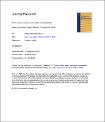Amino acids, ammonia, and hepatic encephalopathy
| dc.contributor.author | Kroupina, Katerina | |
| dc.contributor.author | Bémeur, Chantal | |
| dc.contributor.author | Rose, Christopher | |
| dc.date.accessioned | 2022-05-10T13:46:19Z | |
| dc.date.available | MONTHS_WITHHELD:12 | fr |
| dc.date.available | 2022-05-10T13:46:19Z | |
| dc.date.issued | 2022-04-30 | |
| dc.identifier.uri | http://hdl.handle.net/1866/26644 | |
| dc.publisher | Elsevier | fr |
| dc.subject | Amino acids | fr |
| dc.subject | Ammonia | fr |
| dc.subject | Cirrhosis | fr |
| dc.subject | Hepatic encephalopathy | fr |
| dc.subject | Protein | fr |
| dc.title | Amino acids, ammonia, and hepatic encephalopathy | fr |
| dc.type | Article | fr |
| dc.contributor.affiliation | Université de Montréal. Faculté de médecine. Département de médecine | fr |
| dc.contributor.affiliation | Université de Montréal. Faculté de médecine. Département de nutrition | fr |
| dc.contributor.affiliation | Université de Montréal. Faculté de médecine. Département de pharmacologie et physiologie | fr |
| dc.identifier.doi | 10.1016/j.ab.2022.114696 | |
| dcterms.abstract | Hepatic encephalopathy (HE) is a decline in brain function arising due to liver insufficiency. The liver's diminished capacity to clear ammonia, and the subsequent accumulation of it, is highly implicated in pathogenesis of HE. Ammonia is endogenously generated from the catabolism of amino acids derived from dietary protein intake. Therefore, a conflict arises in cirrhosis where dietary protein intake may increase ammonia and precipitate HE, and at the same time, cirrhotic patients require high daily protein intake due to altered nutrient metabolism. A nutritional solution is needed to deliver sufficient doses of protein to patients without increasing the risk of HE. In order to address this issue, this review will discuss the catabolism of individual amino acids with a special focus on ammonia-generating steps and highlight a subset of amino acids that have the potential to generate multiple equivalents of ammonia. Following, studies investigating the effects of individual amino acids in cirrhosis on blood ammonia levels as well as development of HE will be reviewed. | fr |
| dcterms.isPartOf | urn:ISSN:0003-2697 | fr |
| dcterms.language | eng | fr |
| UdeM.ReferenceFournieParDeposant | 10.1016/j.ab.2022.114696 | fr |
| UdeM.VersionRioxx | Version acceptée / Accepted Manuscript | fr |
| oaire.citationTitle | Analytical biochemistry | fr |
| oaire.citationVolume | 649 | fr |
Fichier·s constituant ce document
Ce document figure dans la ou les collections suivantes
Ce document diffusé sur Papyrus est la propriété exclusive des titulaires des droits d'auteur et est protégé par la Loi sur le droit d'auteur (L.R.C. (1985), ch. C-42). Il peut être utilisé dans le cadre d'une utilisation équitable et non commerciale, à des fins d'étude privée ou de recherche, de critique ou de compte-rendu comme le prévoit la Loi. Pour toute autre utilisation, une autorisation écrite des titulaires des droits d'auteur sera nécessaire.


